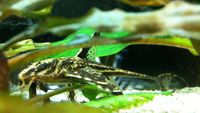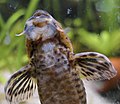Difference between revisions of "Rineloricaria lanceolata"
From The Aquarium Wiki
| Line 38: | Line 38: | ||
==General care== | ==General care== | ||
| − | : These fish can reach a potential size of 12 cm/4.7 inches. They are slightly larger than the more popular species of bristlenose catfish | + | : These fish can reach a potential size of 12 cm/4.7 inches. They are slightly larger than the more popular species of bristlenose catfish [[ancistrus]], however move considerably less. Despite this, they are still interesting fish and can be kept in aquariums as small as 15 gallons. They will eat frozen foods, chopped earthworm and catfish tablets. Pellet foods Amy also be eaten. They require driftwood or bogwood in order to keep the pH around 6.5. They are more active with subdued lighting. Floating plants are recommended. |
==Feeding== | ==Feeding== | ||
Revision as of 06:59, 16 April 2021
Lanceolate Whiptail Catfish
Rineloricaria lanceolata
57 Litres (15 US G.)
7.6-10.2cm (3-4 ")
Freshwater
6.0 - 8.0
25 -28 °C (77-82.4°F)
5-19 °d
1:1 M:F
8-12 years
Family
Loricariidae
| You can contribute to the Aquarium Wiki by expanding this article. Dont be shy!. |
Contents
Additional names
- Lanceolate Whiptail Catfish, Whiptail Catfish
Additional scientific names
- Hemiloricaria lanceolata, Loricaria lanceolata
General care
- These fish can reach a potential size of 12 cm/4.7 inches. They are slightly larger than the more popular species of bristlenose catfish ancistrus, however move considerably less. Despite this, they are still interesting fish and can be kept in aquariums as small as 15 gallons. They will eat frozen foods, chopped earthworm and catfish tablets. Pellet foods Amy also be eaten. They require driftwood or bogwood in order to keep the pH around 6.5. They are more active with subdued lighting. Floating plants are recommended.
Feeding
- They will eat frozen foods, chopped earthworm and catfish tablets. Pellet foods may also be eaten.
Sexing
- Sexing is very straightforward in this species. The male has a much broader head than the female and his cheeks are densely covered with odontodes ("whiskers").
Pictures
External links
- Fishbase (Mirrors:
 )
)


